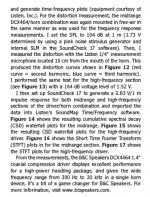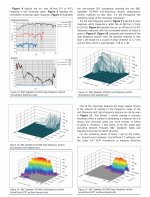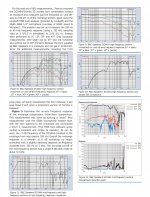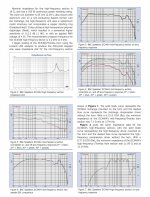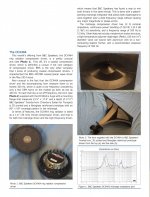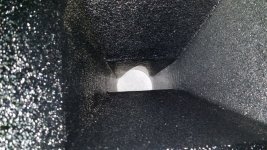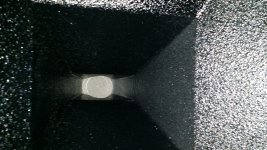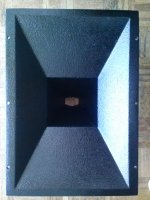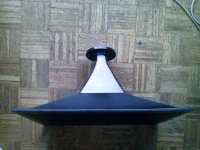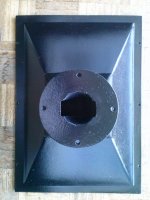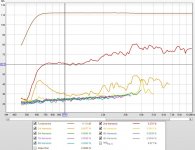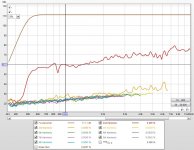Hate to say it, but I haven't yet given a listen to the PAS horns.....been so focused on the synergy. 
I've heard good things about the RCF 940/950 CDs. Price is definitely nicer !
Number of crossovers doesn't bother me though...I'll stay flat phase no matter how many sections I stitch together...it's so easy with FIR.
And I do like how headroom and SPL increase with coax's, compared to single section CDs. (Also like the ability to set limiters for each section independently)
I've heard good things about the RCF 940/950 CDs. Price is definitely nicer !
Number of crossovers doesn't bother me though...I'll stay flat phase no matter how many sections I stitch together...it's so easy with FIR.
And I do like how headroom and SPL increase with coax's, compared to single section CDs. (Also like the ability to set limiters for each section independently)
@Peter Morris: As you'll know, throughout the years Krix has developed numerous horns based on the research of Richard C. Morgans et al.
Krix also issued a number of patents on their advanced diffraction technology.
Except for the smaller 1" horns, most of the larger diffraction horns feature unconventional throat sizes.
I guess your Krix horns (for the mid/high cab) are medium-sized, and would normally be used by Krix with either a 4 or 3" diaphragm driver?
It would be interesting to see some measurement data of the mid/high with the Krix horn.
A few examples of similar horns. The top horns of the Krix 4 way systems are 1" and the throat size of the mid/high horns may vary.
Krix also issued a number of patents on their advanced diffraction technology.
Except for the smaller 1" horns, most of the larger diffraction horns feature unconventional throat sizes.
I guess your Krix horns (for the mid/high cab) are medium-sized, and would normally be used by Krix with either a 4 or 3" diaphragm driver?
It would be interesting to see some measurement data of the mid/high with the Krix horn.
A few examples of similar horns. The top horns of the Krix 4 way systems are 1" and the throat size of the mid/high horns may vary.
Attachments
-
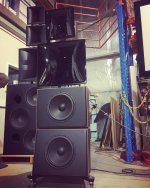 IMG_6205.JPG.9611879b392e637531308f450633fc31.jpg722.8 KB · Views: 802
IMG_6205.JPG.9611879b392e637531308f450633fc31.jpg722.8 KB · Views: 802 -
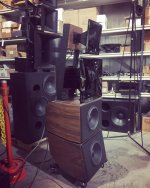 IMG_6204.JPG.e974c68467dcc1d4cfe9d7b6efe97ac1.jpg645.3 KB · Views: 788
IMG_6204.JPG.e974c68467dcc1d4cfe9d7b6efe97ac1.jpg645.3 KB · Views: 788 -
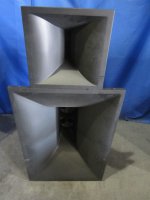 KRIX KX-3930 Mid Range & High Frequency System MIB NOS_Big.jpg637.6 KB · Views: 718
KRIX KX-3930 Mid Range & High Frequency System MIB NOS_Big.jpg637.6 KB · Views: 718 -
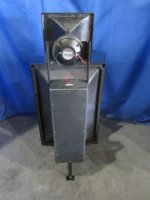 KRIX KX-3930 Mid Range & High Frequency System MIB NOS_Big_2.jpg457 KB · Views: 706
KRIX KX-3930 Mid Range & High Frequency System MIB NOS_Big_2.jpg457 KB · Views: 706 -
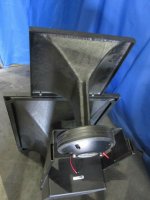 KRIX KX-3930 Mid Range & High Frequency System MIB NOS_Big_3.jpg493.2 KB · Views: 707
KRIX KX-3930 Mid Range & High Frequency System MIB NOS_Big_3.jpg493.2 KB · Views: 707 -
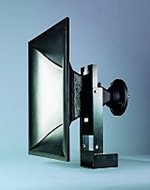 Krix_3010_Big.jpg189.6 KB · Views: 246
Krix_3010_Big.jpg189.6 KB · Views: 246
Last edited:
Hate to say it, but I haven't yet given a listen to the PAS horns.....been so focused on the synergy.
I've heard good things about the RCF 940/950 CDs. Price is definitely nicer !
Number of crossovers doesn't bother me though...I'll stay flat phase no matter how many sections I stitch together...it's so easy with FIR.
And I do like how headroom and SPL increase with coax's, compared to single section CDs. (Also like the ability to set limiters for each section independently)
What are the dimensions of the PAS horns? They look somewhat similar to my own horns, except for the depth > mine are 30.8 cm.
Ease of implementing additional XOs is indeed a big advantage of DSP, another is dialing in of horns.
If you have the possibility to play (extremely) loud and/or use Synergies for PA, the coaxials definitely have the edge. For hi-fi at home, the 2 way option (e.g. ND940 + 2x MB12N405) provides more headroom than you'll ever need.
Last edited:
What are the dimensions of the PAS horns? They look somewhat similar to my own horns, except for the depth > mine are 30.8 cm.
Ease of implementing additional XOs is indeed a big advantage of DSP, another is dialing in of horns.
If you have the possibility to play (extremely) loud and/or use Synergies for PA, the coaxials definitely have the edge. For hi-fi at home, the 2 way option (e.g. ND940 + 2x MB12N405) provides more headroom than you'll ever need.
Mine are 75x43 cm, and 40.6 cm deep. (29.5x17x16" D)
Are yours 2" exit too? Like them?
You are really right about the ND940 being more than enough for home (as in way more
Mine are about 61W x W41 x D31, so a little smaller overall. The throat is 2".
Basically they are scaled up JBLs 2380A, albeit with a relatively short diffraction slot(length).
These sound rather nice crossed at 750Hz. I don't recognize the artefacts that many people seem to have experienced with such horns.
Actually I prefer the sound of my horns to almost any of the smaller waveguides.
The mouth section of the PAS horns looks quite similar to that of Bjørn Omholt's Bi-Radial horns (designed by Don keele), but the slot appears to be longer.
You might be pleasantly surprised by the PAS horns with the DCX464 high passed at 500 or 600Hz on top of a bass cab.
Basically they are scaled up JBLs 2380A, albeit with a relatively short diffraction slot(length).
These sound rather nice crossed at 750Hz. I don't recognize the artefacts that many people seem to have experienced with such horns.
Actually I prefer the sound of my horns to almost any of the smaller waveguides.
The mouth section of the PAS horns looks quite similar to that of Bjørn Omholt's Bi-Radial horns (designed by Don keele), but the slot appears to be longer.
An externally hosted image should be here but it was not working when we last tested it.
An externally hosted image should be here but it was not working when we last tested it.
You might be pleasantly surprised by the PAS horns with the DCX464 high passed at 500 or 600Hz on top of a bass cab.
Last edited:
Mine are about 61W x W41 x D31, so a little smaller overall. The throat is 2".
Basically they are scaled up JBLs 2380A, albeit with a relatively short diffraction slot(length).
These sound rather nice crossed at 750Hz. I don't recognize the artefacts that many people seem to have experienced with such horns.
Actually I prefer the sound of my horns to almost any of the smaller waveguides.
The mouth section of the PAS horns looks quite similar to that of Bjørn Omholt's Bi-Radial horns (designed by Don keele), but the slot appears to be longer.
You might be pleasantly surprised by the PAS horns with the DCX464 high passed at 500 or 600Hz on top of a bass cab.
That's great news, and strong motivation to get my butt in gear and try that..
Thx !
In general, the shorter the diffraction slot, the less likely it is that typical diffraction side effects will manifest themselves.
The opening of the slot in your PAS horns isn't very narrow, which is also a good thing.
The fact that Bjorn Omholt sold his (highly regarded) Klipsch K402s, because he preferred the Bi-Radials, contradicts the prevalent misconceptions wrt diffraction horns.
The opening of the slot in your PAS horns isn't very narrow, which is also a good thing.
The fact that Bjorn Omholt sold his (highly regarded) Klipsch K402s, because he preferred the Bi-Radials, contradicts the prevalent misconceptions wrt diffraction horns.
Last edited:
Closeups of the horn that BMS specifically designed for their coaxial compression drivers.
Attachments
In general, the shorter the diffraction slot, the less likely it is that typical diffraction side effects will manifest themselves.
The opening of the slot in your PAS horns isn't very narrow, which is also a good thing.
The fact that Bjorn Omholt sold his (highly regarded) Klipsch K402s, because he preferred the Bi-Radials, contradicts the prevalent misconceptions wrt diffraction horns.
I've been having a lot of fun with bi-radials for the past couple years, here's how I make them: How to Make a New Wave Biradial Horn
About a month ago I figured out how to make them asymmetrical, my latest project is an example of that : Celilo : A Small, Affordable Two-Way Unity Horn
Yikes! That looks terrible.
It does indeed, yet it didn't stop a French manufacturer from using it in a MTM.
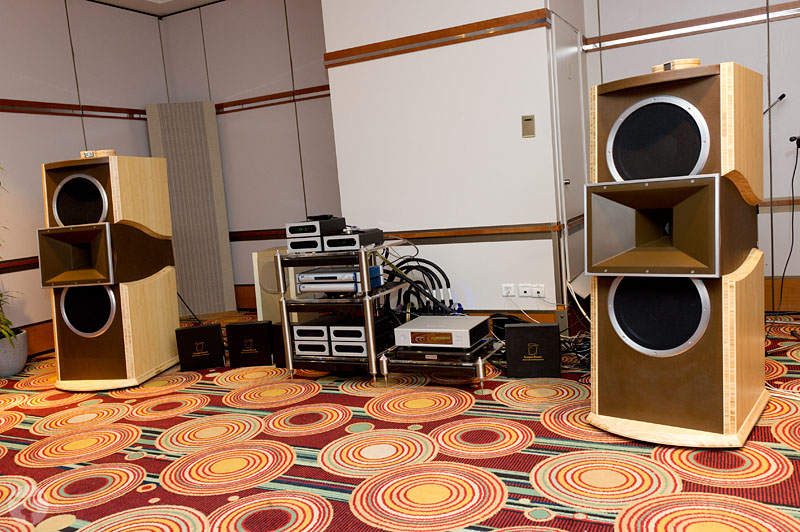
I've been having a lot of fun with bi-radials for the past couple years, here's how I make them: How to Make a New Wave Biradial Horn
About a month ago I figured out how to make them asymmetrical, my latest project is an example of that : Celilo : A Small, Affordable Two-Way Unity Horn
Cool projects as usual.
I really like the concept of the celilo. Your reasoning and reference to the Danley Jericho's makes sense.
BTW, did you buy a bigger 3d printer?
For the sake of completeness:
The frequency response and waterfall plots look excellent! I'll have to buy a pair for my own testing.
The mouth section of the PAS horns looks quite similar to that of Bjørn Omholt's Bi-Radial horns (designed by Don keele), but the slot appears to be longer.


Bit unrelated, but I was drawn into this thread and could not other than note thats my horn!
Might be interested in trying out the DCX464 on it, but I would like to know some more experiences about its (comparative) loudness and quality.
THD plots, dcx464 and bms4594he, taken at same time on xti1464.
In a clothes closet, mic 6" from mouth.
SPL is accurate.
Freq response is accurate, not normalized.
1/48th smoothing, no windows or gating. (Obviously EQ'ed very flat, was trying out a new FIR technique.)
THD % are at 1kHz (996Hz)
I'll need to get outside and run tests at much higher levels to really know anything...but maybe these help anybody thinking about using either of these drivers for home-fi...
DCX464 first ....this is it's thread, huh?
In a clothes closet, mic 6" from mouth.
SPL is accurate.
Freq response is accurate, not normalized.
1/48th smoothing, no windows or gating. (Obviously EQ'ed very flat, was trying out a new FIR technique.)
THD % are at 1kHz (996Hz)
I'll need to get outside and run tests at much higher levels to really know anything...but maybe these help anybody thinking about using either of these drivers for home-fi...
DCX464 first ....this is it's thread, huh?
Attachments
Hi mark100,
I apologized, why goes only to 10kHz?
Hi 1hiep0, harmonics of fundamentals beyond 10kHz all > 20kHz... beyond audibility.
- Home
- Loudspeakers
- Multi-Way
- B&C DCX464
